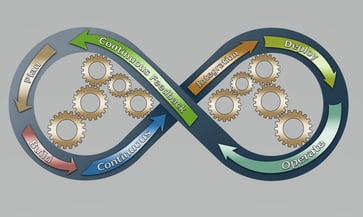Recently, I was speaking with the Chief Transformation Officer from one of our clients. After we described how a commercial transformation progressed when supported by our Negotiating with Backbone framework, he asked, “Is there anything else I should know?”
To answer him, I described one transformation I had recently been involved in that was very successful and another one that failed miserably. In the comparison, I focused on four crucial activities that I believe make a transformation successful and highlighted how each company had, or failed, to complete them.
This was the first time I had thought about the success or failure of a commercial transformation in these terms. So, when asked to formalize these ideas for our Executive Forum, I did some research on what others have said about successful transformation and was surprised to learn that most transformations are not successful.
So, if you are serious about a commercial transformation, I encourage you to measure these activities as leading indicators of the success of your initiative.
- Do you have a transformation story that resonates?
James Hewitt, in his book Exponential, said "Human brains work best in a hopeful state. We will be better prepared to consider all possibilities if we reflect on what may come with hope as the starting point."

Successful transformations require that companies impart a sense of hope through their transformation story-one that is engaging, inspiring and, communicated regularly.
Thinking back to the company with the successful transformation, I realized that their communication was extremely well-orchestrated. We heard about the reasons for the transformation every week, if not every day. The leaders constantly talked about the successes of the transformation, and all communications and activity were tied to improving customer outcomes. The shared vision of the future was compelling and inspiring, and we all believed we could win together as a team.
In contrast, the company with the unsuccessful transformation had a story that was constantly changing without any real connection to the customer. There were multiple top-down directives creating confusion and diminishing trust. People knew that a transformation was happening, but nobody was clear as to what it was or if it was successful. That drained the transformation project of hope and ultimately led to failure.
- Are your organizational leaders committed and present?
In How to Beat the Transformation Odds, a survey of transformations by McKinsey & Company, it states, "Success is twice as likely when senior leaders and the leaders of initiatives spend more than half of their time on the transformation. In practice, though, only 43 percent of these leaders say they invested that much working time in the transformation's initiatives."
 Let's look again at the successful transformation. The leadership team was very active in the transformation process; the highest levels of leadership across the organization, not just the transformation officer, were walking the walk and talking the talk. There was an adequately staffed transformation team, and all levels of leadership-from the C-suite to the Senior Managers had some active involvement in the transformation projects and were held accountable to the results via performance evaluations.
Let's look again at the successful transformation. The leadership team was very active in the transformation process; the highest levels of leadership across the organization, not just the transformation officer, were walking the walk and talking the talk. There was an adequately staffed transformation team, and all levels of leadership-from the C-suite to the Senior Managers had some active involvement in the transformation projects and were held accountable to the results via performance evaluations.
In contrast, the unsuccessful transformation had no dedicated structure or resources assigned to the efforts. Most of the time was spent creating 100-page PowerPoint presentations for board meetings versus actually doing the work to affect change. Just thinking about it now makes me anxious and frustrated - similar to the feelings that most employees experienced during the work effort.
- Have the RIGHT resources been identified?
In BOLD – Essential Leadership for Transformative Change by Chris Mahai, she says the essential traits for BOLD leaders are curiosity, confidence, empathy, and trust. In the chapter, “BOLD: A C-Suite Conversation,” Mahai goes on to say that organizations should “identify and assign BOLD leaders when you face critical transformational challenges, give them clear assignments and expectations, provide resources and some rope to dive in and execute, and support them with cover to do the change and transformation work you need them to do.”

I completely agree. Choosing the right people to lead your transformation is incredibly important, as is providing adequate training and skill development to ensure they are successful. When corporate anti-bodies—those that do not want to change—have important roles in your transformation project, it can be devastating to a well-intentioned transformation.
In the unsuccessful transformation, the people assigned by executives to run the transformation projects were ironically the ones who didn’t believe change was possible. They had every reason under the sun to believe that the project would produce no tangible success. “We’ve tried that before,” was a common phrase heard within each project team. Can you imagine the impact that dialogue had inside the organization? Additionally, every single project team was filled with people who said they would do something yet would be too busy to meet their commitment. Weeks would pass with the same project update, "I will do it by next week". The BOLD leaders in the organization got frustrated and left the company.
As for the successful transformation, I don’t even need to paint the picture of what the people component looked like. Let’s just say it was a joy to go to work, to accomplish things as a team, to support one another, to meet commitments, and solve complex problems together. The rewards of the hard work were abundant, and I have never had a more fulfilling time in my career than when working inside a successful transformation.
- What is your long-term vision?
It is so important to create a culture where people expect to be better tomorrow than they are today. Encouraging people to improve upon things and focusing on the long-term goals instead of the short-term project will help a transformation in so many ways.
According to How to Beat the Transformation Odds, “By implementing continuous-improvement activities that enable the organization to look regularly for new and better ways to work, respondents’ organizations double their chance of successfully sustaining improvements after the transformation.”

Make no mistake, long-term vision is equally about organizational culture as it is about transformation. If we do not spend the time to shift the organization’s culture and only focus on project work, we will never sustain improvements over time. When we couple continuous improvement with a focus on the customer, we can help people in the organization connect their work with a higher purpose and outcome.
You might have guessed that in the unsuccessful transformation, the focus of each project was short term. Everyone was hoping the project would end or the executive team's focus would shift to something else. There was no view of the long term or how change would be sustained when the transformation efforts ended.
In contrast, the successful transformation took the long-term approach. They invested heavily in projects that would create efficient systems and processes while improving customer outcomes. The company even involved their customers in some of the diagnostic work to improve systems, tools, processes, and approaches.
Transformation work is not for the faint of heart. It takes great energy, a positive and enthusiastic attitude, and excellent communication skills. It requires a different kind of leader who is courageous and BOLD. One who is willing to spend the majority, if not all, of their time thinking about and working on transformation. It requires executive leadership actively supporting the change agents in the organization and breaking through the walls of resistance. It requires creating a compelling story about the transformation that inspires the organization to change and gives people hope that they will be better tomorrow than they are today. It requires an ongoing commitment to continuous improvement beyond the transformation project work.
I would love to hear from you on what’s worked well as you’ve undertaken or completed commercial transformation efforts. What makes your transformations successful? What would you have changed to improve upon the successes of your transformation efforts?

.jpg)